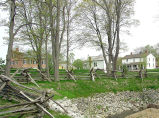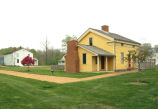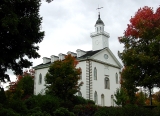Ohio Period
- Return to general Mormon history article.
- Return to previous time period.
The Mormons in Ohio
Persecution dogged the Latter-day Saints in New York, where The Church of Jesus Christ of Latter-day Saints, then referred to as the Mormon Church, had been founded in 1830. In late 1830, Joseph Smith received a revelation commanding him and the other members of the Church of Jesus Christ to move to Kirtland, Ohio, where a strong congregation had sprung up. In January 1831, Joseph Smith arrived in Kirtland and greeted the new converts. Immediately, he and the other leaders began organizing and ordering the Church. In May that year, the other Latter-day Saints from New York came to Kirtland. This small town near Cleveland became the headquarters of the Church from January 1831 to December 1837 (see 1830s). This period is one of the most important periods in Church history for doctrine and organization. Edward Partridge was asked to be a bishop. Other officers were called. The Lord commanded the Saints to buy land and divide it among the poor so that everyone could have a place of inheritance. All the poor among them were helped.
In July 1831, a revelation commanded Joseph and others to go to Missouri. There the Lord revealed that Jackson County was the center place for the gathering of the Church of Jesus Christ. Throughout the next several decades, this idea of gathering was essential to Latter-day Saint teachings, and still plays a great role. Immediately, the Church bought lands in Jackson County, and many members of the Church of Jesus Christ began migrating there. In November, the Church began to collect the revelations received by Joseph Smith into one volume that would later be called the Doctrine and Covenants. Edward Partridge was assigned to stay in Missouri and lead the Church there. Newel K. Whitney became bishop in Kirtland.
The next few years in Kirtland were both trying and glorious. Many revelations were received by the Prophet. In April, Joseph Smith was recognized and sustained as President of the Church. A newspaper was published called the Evening and Morning Star. The Church also purchased the scrolls that Joseph Smith translated as the Book of Abraham. However, many trials came. Persecution continued by neighbors who feared the power of these new move-ins, and others spread scandalous libel about Joseph and other leaders. In March 1832, on a cold night, Joseph Smith and Sidney Rigdon, a local convert who had become one of the leading spokesmen for the Church, were tarred and feathered. Joseph's adopted infant son died from exposure caused by the mob's invasion of Joseph's home. Joseph and Emma would eventually have eleven children, six of whom would die in infancy.
In 1833, construction of the first temple [1]was begun in Kirtland. The Latter-day Saints felt it was a commandment and blessing from God to build this temple, even though they were very poor at the time. Also near this time, Joseph received the revelation that came to be known as the Word of Wisdom[2]. This revelation manifested that alcohol, tobacco, coffee, and tea are harmful to the body and spirit and should be avoided. It also enjoined the use of wholesome herbs, fruits, and vegetables, and encouraged people to eat meat sparingly.
Meanwhile, the Latter-day Saints in Jackson County, Missouri, were being persecuted and driven. They were expelled from their homes in November 1833. After ineffectual appeals to local and state governments, Joseph Smith organized Zion's Camp to aid the beleaguered Saints in Missouri, which they called Zion. Ultimately Zion's Camp included over 200 men and over twenty women and children. The aim was not a military offensive, but, rather, assistance and defense of the driven and persecuted members of the Church. The members of Zion's Camp suffered much along the way, and when they arrived, they found the members in Missouri already driven into Clay County, just north of Jackson County. Since the state refused to help the "Mormons," as they were called, even though they had been unjustly and illegally driven from their land, Joseph and the other leaders helped the exiles obtain temporary shelter in Clay County until more permanent arrangements could be found. The good people of Clay County, though not desirous of having the Mormons live among them, nevertheless permitted them to recoup their strength for a time.
Returning from Zion's Camp, Joseph and other leaders organized the governing bodies of the Church. They established the Quorum of the Twelve Apostles, and the Seventy. Both groups immediately departed on proselyting missions. Later in August 1835, the first copy of what was to become known as the Doctrine and Covenants was published under the name Book of Commandments.
1836 proved to be both a glorious and tragic year. The Kirtland Temple was completed in the spring and was dedicated in March. The day of dedication was full of pentecostal manifestations. Many reported seeing angels and visions. Others heard angels singing. Some spoke in tongues. Some saw fire atop the temple. In April, while praying fervently in the temple, Joseph Smith and Oliver Cowdery beheld vision of the Savior, Jesus Christ[3], and were visited by several of the ancient prophets, who bestowed the keys of their dispensations to Joseph Smith to usher in the "dispensation of the fullness of times." In November, several leading members of the Church, including Joseph Smith, established a bank called the Kirtland Safety Society. Financial troubles caused by rampant speculation and a nationwide panic in 1837 led to the collapse of the Kirtland Safety Society. Many blamed Joseph and called him a fallen prophet. Embittered former members stirred up persecution against the Church in the surrounding counties. In 1837, the Twelve Apostles left on missions to England, the first foreign mission of the Church of Jesus Christ. Meanwhile, a revelation came to Joseph that the Church needed to be in one body. He left in late 1837 for Far West, Missouri. The rest followed over the next few years, most of them in spring 1838. The glorious days of Kirtland were over. The Church moved west.
- Proceed to next time period.


